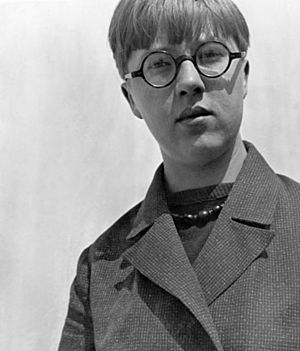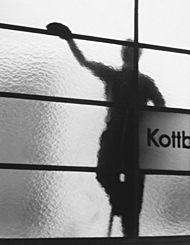Elsa Thiemann facts for kids
Quick facts for kids
Elsa Thiemann
|
|
|---|---|
 |
|
| Born | 7 February 1910 Toruń, West Prussia
|
| Died | 15 November 1981 (aged 71) |
| Other names | Elsa Franke-Thiemann |
| Education | Bauhaus |
| Occupation | Photographer |
| Spouse(s) | Hans Thiemann (married 1947–1977) |
Elsa Thiemann (born Elsa Franke, February 7, 1910 – November 15, 1981) was a German photographer. She was also a student at the famous Bauhaus art school. Elsa also designed unique wallpaper. She made these designs using a special photo technique called photograms.
Elsa's Early Life and School
Elsa Thiemann was born in a city called Toruń. This city was in West Prussia, which is now part of Poland. In 1921, her family moved to a suburb of Berlin called Neukölln.
Her family supported her art studies. She went to two art schools in Berlin. These schools later became the Universität der Künste Berlin, or Berlin University of the Arts.
In 1929, Elsa began studying at the Bauhaus. This was a very important art and design school. She earned her diploma from Bauhaus in July 1931.
During her first year, she took a basic course with Josef Albers. Then, she studied photography with Walter Peterhans. This photography course was part of the school's printing and advertising workshops. Elsa also took painting classes. Her teachers for painting were famous artists like Wassily Kandinsky and Paul Klee.
Elsa created wallpaper designs while at Bauhaus. However, her designs were never sold as part of the Bauhaus wallpaper collection. This was because her work looked very different. Other Bauhaus wallpapers were often bright and cheerful. Elsa's designs used dark collaged photograms. She made these by placing plants, thread, and paint blobs on photo paper.
At the Bauhaus, Elsa met a painter named Hans Thiemann. He lived from 1910 to 1977. After he finished his studies in 1933, they lived together in Berlin.
Elsa's Photography Work
From 1931, Elsa Thiemann worked in Berlin. She was a freelance photographer, meaning she worked for herself. She also worked as a press photographer, taking pictures for newspapers.
During the Nazi period, all working artists had to join an organization called the Reichskulturkammer. Elsa joined in 1934 so she could keep working. Elsa did not agree with the Nazis. Also, Hans Thiemann's surrealist art was called "Degenerate art" by the Nazis. This meant they thought his art was bad.
To stay safe and avoid trouble, Elsa took photos that did not seem political. Instead, she photographed everyday street scenes. She often took pictures around Hertzbergstrasse in Neukölln, where she lived. Sometimes, she even took photos directly from her apartment windows.
During World War II, Elsa and Hans stayed in Berlin. Elsa worked as an assistant for a publishing company.
Hans was part of an artists' group in Berlin called the Fantasten (Dreamers). Elsa took many portraits of Hans and the other artists in this group.
Today, Elsa is best known for her street photography of Berlin. She took pictures of the city before the war. She is especially famous for her photos of Berlin's ruins after the war.
Elsa and Hans Thiemann got married in 1947. In 1960, Hans got a job at the Hochschule für bildende Künste Hamburg. This is the University of Fine Arts, Hamburg. After this, Elsa stopped taking photographs.
Elsa Thiemann passed away in Hamburg on November 15, 1981. Her artworks are kept in several places. These include the Museum Neukölln, the Bauhaus Dessau Foundation, and the Bauhaus Archive in Berlin. You can even buy gift wrap with her Bauhaus wallpaper designs at the Bauhaus Archive shop. In 2004, the Bauhaus Archive held a special show just for her work.
See also
 In Spanish: Elsa Thiemann para niños
In Spanish: Elsa Thiemann para niños


